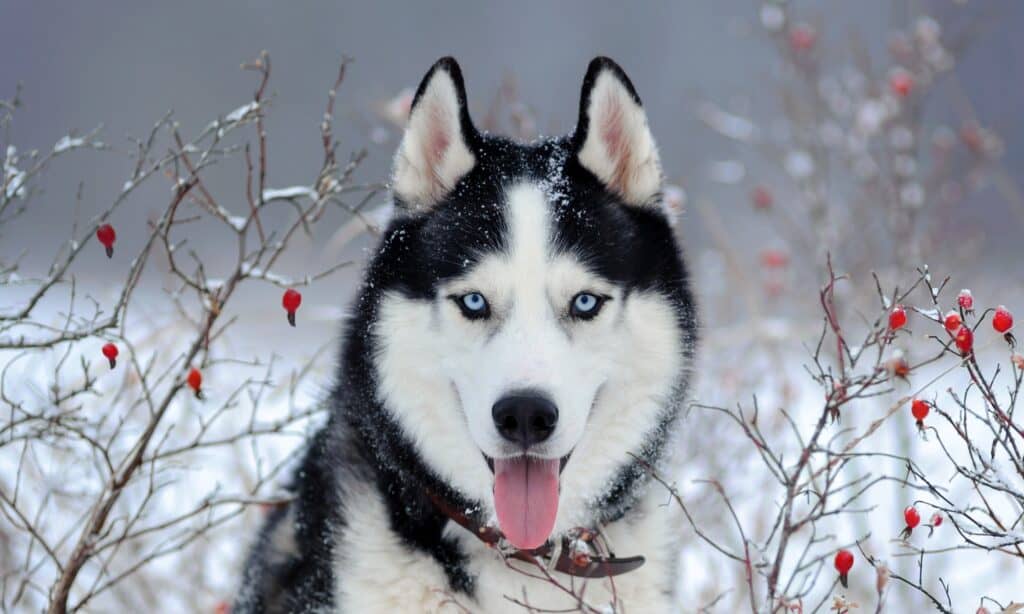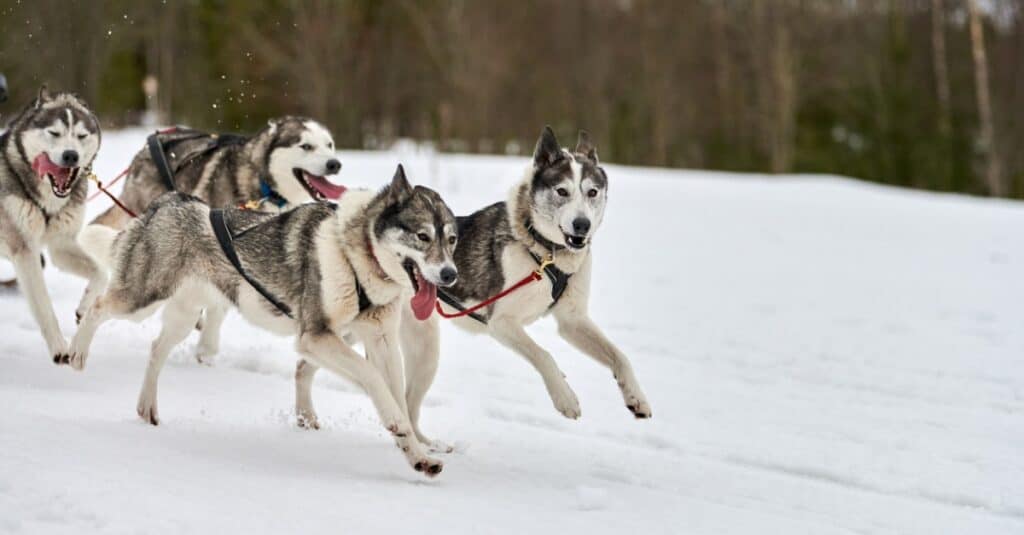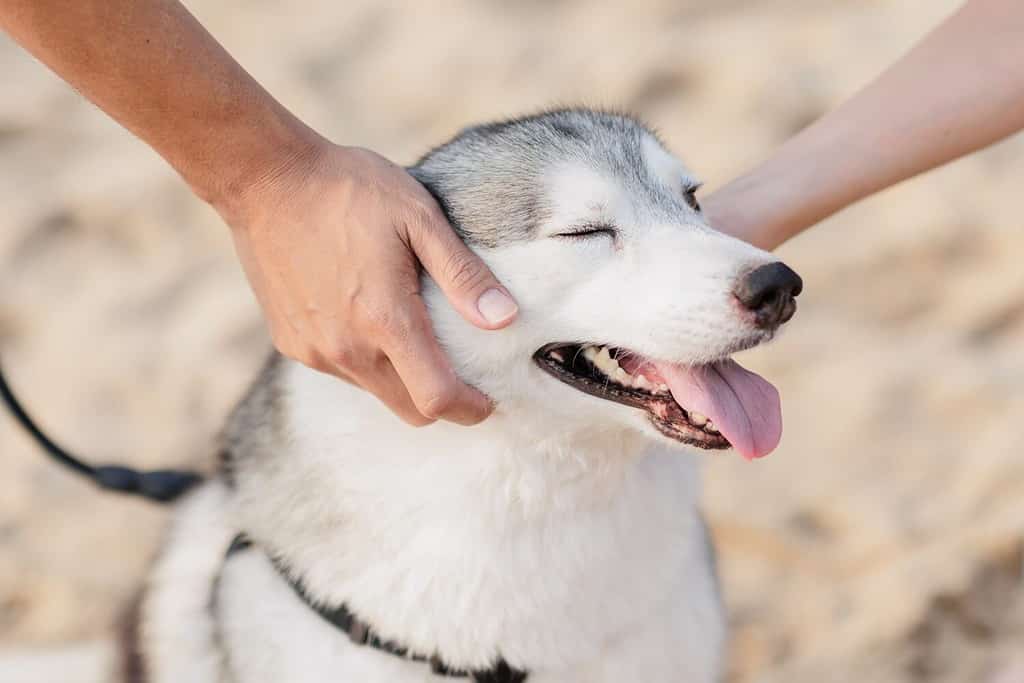Originally bred as working dogs, huskies are known for their incredible sled-pulling skills. Loyal, friendly, and a tad mischievous, huskies make fantastic family dogs. However, there are subtle differences between male vs. female huskies. Here are some key differences that will help you in your selection.
1. Size

Generally, male huskies grow larger than female huskies, but it is not always the case.
©Sbolotova/Shutterstock.com
In general, male huskies may grow 15 to 20 percent larger than females. The average male husky weighs between 45 and 60 pounds, whereas a female husky weighs between 35 and 50 pounds. Also, a male husky will grow to be 21 to 23.5 inches tall, while females only reach 20 to 22 inches in height.
2. Dominance Behaviors

Both male and female huskies may show aggression, but males who have not been neutered are more likely to exhibit aggression than female and neutered male huskies.
©iStock.com/Elayne Massaini
In general, male huskies have more of a need to establish dominance. This may be a problem if you already own a husky or other dog breed. Your male husky may try to charge the other dog, curl his lips, or stand over the other dog to prove his dominance. So, it is important to establish your dominance in the home to prevent conflicts.
Another way your male husky may display dominance is by marking his territory in your home. Huskies who have not been neutered are more prone to this behavior. It’s unpleasant, but there are several ways to work with your husky on this. A few options are positive reinforcement of outdoor peeing, reducing stress triggers, or using an enzymatic cleaner.
However, because of their territorial instincts, male huskies make fantastic guard dogs and protectors of their pack.
3. Independent Vs. Dependent

Female huskies tend to be more independent at home than male huskies.
©iStock.com/format35
While the difference is subtle, female huskies tend to be more independent. Male huskies crave their human “pack” more than females do. So, your male husky will be more likely to follow you from room to room, while your female husky will be content to be nearby or check on you from time to time.
4. Trainability

Overall, female huskies are easier to train than male huskies.
©iStock.com/ortlemma
Because female huskies are less dominant than their male counterparts, they will be more likely to submit to your authority. That doesn’t mean males can’t be trained. It just means males may be more challenging and require more repetition to listen and obey. Females are more likely to accept you as their leader quickly.
5. Activity

Male huskies require more playtime and exercise to be tired out.
©iStock.com/TRAVELARIUM
In general, huskies are active and energetic dogs. You will have happier, more receptive dogs by ensuring they get at least two hours of exercise each day. However, male huskies tend to have more endurance because of their size potential. So, it can take more effort to tire your male husky compared to your female husky.
6. Healthcare

Spaying is a more invasive operation than neutering. Thus, it is usually more expensive.
©Sbolotova/Shutterstock.com
Huskies of both genders must receive regular grooming sessions to keep their coats healthy. Also, keeping nails trimmed for healthy paws and maintaining dental hygiene (as dental disease plagues huskies in particular) is critical.
But, if you are considering spaying or neutering, spaying for a female dog tends to be more expensive. Because it is a more invasive procedure, spaying is 20 to 30 percent more expensive than neutering.
7. Huskies as Family Dogs

Both male and female huskies are extremely affectionate. However, males may be more obvious in their displays of affection.
©Noom HH/Shutterstock.com
Huskies are known as affectionate and friendly dogs. This even-tempered breed is low on the aggression scale and can be quite tolerant of the antics of young children. Male huskies tend to be more energetic and outgoing. They are more likely to initiate play, and because they stick close to their pack, many families prefer the dependent nature of male huskies.
Conversely, females tend to be more calm and nurturing, which families with young children often need. Their independent nature may be preferred by owners who do not like to be followed around the house.
But both male and female huskies are good-natured and great family pets.
8. Huskies and Other Family Pets

Male huskies may require more training to integrate them with the rest of the family pets.
©Vivienstock/Shutterstock.com
Because of a male husky’s tendency towards dominance, a male may have a harder time integrating with other dogs or pets in the family. Dominance, territorial behaviors, and food aggression might be the biggest hurdles with a male husky. Because female huskies are easier to train and often more submissive, they often get along well with established family pets. But with good training and intentional leading, both genders can be an enjoyable addition to your group of family pets.
The photo featured at the top of this post is © Ksenia Raykova/Shutterstock.com
Ready to discover the top 10 cutest dog breeds in the entire world?
How about the fastest dogs, the largest dogs and those that are -- quite frankly -- just the kindest dogs on the planet? Each day, AZ Animals sends out lists just like this to our thousands of email subscribers. And the best part? It's FREE. Join today by entering your email below.
Thank you for reading! Have some feedback for us? Contact the AZ Animals editorial team.







